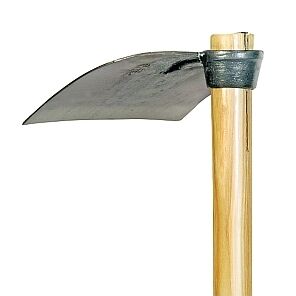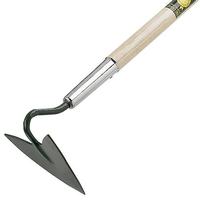How many different types of garden hoe are there?
Author: Greg Baka
All the hoe shapes, styles, and designs: Simplified
There are a lot of different names, flavors, and descriptions out there. A couple hours of online searching created a list that grew and grew to a total of 48 unique garden hoe names. And that was without including brands, spelling differences, and regional name variations!
But when you start to group them by what the hoe is USED FOR, and what the ACTION is to make it work, then there are just 5 different categories of garden hoes.
Do you know what all 5 are? (Hint - the picture below contains only 3 of the categories)
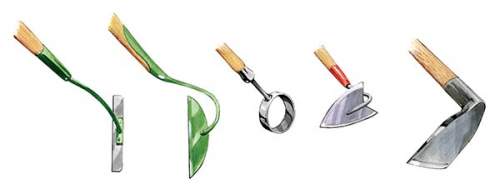
Image Credit Artist = Elayne Sears
First, let's sort the 48 hoes into 5 categories based on...
...what they are most useful for,
...the action used to operate the tool,
...and what soil type they work best in.
We will also show you how your old garden hoes can be made more efficient, and how to pick replacements for the hopeless ones in your tool pile. There is no such thing as a universal garden hoe - they each only do one or two tasks well.
Here are all 48 in alphabetical order...
Action, American Standard, Circle, Cobra Head, Coleman Hoe, Collinear, Cultivator hoe, Diamond, Draw, Dutch, Eye hoe, EZ Digger, Field, Floral, Fork, Goose neck, Grape, Grub, Gung-hoe, Half Moon, Heart, Hooke-and-Crooke, Hula, Korean Ho-Mi, Loop hoe, Onion, Oscillating, Paddle, Pattern, Plow hoe, Pointed, Potato fork, Pull spork, Push, Push-n-Pull, Ridging, Scovil, Scuffle, Speed, Stirrup, Swage hoe, Swan neck, Swoe, Trapezoid, Upright Hoe, Warren, Winged weeder, and Wire weeder.
Whew! That is a confusing jumble. So let's make it simpler and group them into the right category.
List of 5 garden hoe categories:
- Digging hoes: for digging and tilling, with a chopping action
- Draw hoes: for weeding, with pulling / scraping action
- Reciprocating hoes: for weeding, with a scrubbing action (has a blade that moves)
- Flat hoes: for weeding, with a push-pull action (has a blade that lays flat on the soil)
- Sweeping hoes: for weeding, with a sweeping action (handle held fairly straight up)
(each group name is clickable link that will jump you down to it's section)
Group #1: Digging Hoes
Action = Chop
Purpose = Digging and Tilling in all soils
The first (and oldest) style are the ones that started way back when agriculture began. They are used to chop through sod to make a garden space. They are also used to keep that soil tilled up and loose.
These tools typically have a heavy blade or tines that chops into the soil at a 45 degree angle. The handle makes about an 80 degree angle with the blade. The heavy weight is important because it builds momentum as the tool swings downward,and helps them easily penetrate the soil. *Note - remember this paragraph because it also explains why part of the "Draw" category below is hard to use.
It is best to chop thin slices of sod or soil (an inch or two) and then pull the handle back towards you to move or till the slice.
(See our
Although these tasks can now also be done with a plow or rototiller, these tools are still used here and around the world by those practicing small-scale agriculture, and by normal gardeners who want to avoid the cost and hassles of gas powered equipment.
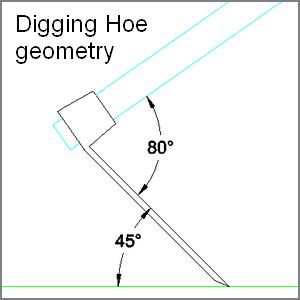
These tools typically have a heavy blade or tines that chops into the soil at a 45 degree angle. The handle makes about an 80 degree angle with the blade. The heavy weight is important because it builds momentum as the tool swings downward,and helps them easily penetrate the soil. *Note - remember this paragraph because it also explains why part of the "Draw" category is hard to use.

It is best to chop thin slices of sod or soil (an inch or two) and then pull the handle back towards you to move or till the slice. (See “How to Use a Grub Hoe” article)
Although these tasks can now also be done with a plow or rototiller, these tools are still used here and around the world by those practicing small-scale agriculture, and by normal gardeners who want to avoid the cost and hassles of gas powered equipment.
Group #2: Draw Hoes
Action = Pull / Scrape
Purpose = Weeding in hard or soft soil
This group contains the ones that people are most familiar. If you ask someone to sketch a “garden hoe”, this is what you will get.
The word "draw" also means "to pull". These tools are used by pulling or drawing them towards you. The blade scrapes at or below the the soil surface. If scraping at the surface, the blade will rip or slice the weed stems. If scraping below the surface, it will uproot the weeds.
The hoe head is light - it does not need to be heavy, because this design is not meant for digging deep into the soil.
The blade should contact the soil at a 20 to 30 degree angle, which is optimal for scraping. And the angle between the blade and handle should be about 60 degrees, plus or minus depending on the handle length and your height. And here is where the trouble starts...
The trouble, or problem, with many Draw Hoes is that people do not adjust the neck of the hoe. The "neck" is the rod that connects the blade to the handle. The only reason the neck is there is to allow the user to allow to fine tune the tool so that the end of the handle is at comfortable level for their height, AND AT THE SAME TIME allow the blade to make the proper angle with the soil.
See our article "Adjust your garden hoe" for full instructions and a printable bending template.

The hoe head is light - it does not need to be heavy, because it is not meant for digging deep into the soil.
The blade should contact the soil at a 20 to 30 degree angle, which is optimal for scraping. And the angle between the blade and handle should be about 60 degrees, plus or minus depending on the handle length and your height. And here is where the trouble starts...

The trouble, or problem, with many Draw Hoes is that people do not adjust the neck of the hoe. The neck is rod that connects the blade to the handle. The only reason the neck is there is to allow the user to allow to fine tune the geometry of the tool so that the end of the handle is at comfortable level for their height, AND allow the blade to make the proper angle with the soil. See the article "How to easily adjust a garden hoe to match your height".
Let's list the types of Draw Hoes, and tell their pros and cons.
Standard Draw Hoes:
These are the most common hoes. You can find them at every hardware or big-box store in the land...and they are the worst ones.
This is the group that people have the most trouble with, and the ones that create the general impression that hoeing a garden is really difficult, back-breaking, and time-sucking.
They are rarely made with the blades at the right angle, and many are built with such thick necks that they can not be adjusted. Since the angle is wrong, people often end up hacking at weeds with these hoes, which is what gives hoeing the garden it's bad rap as an exhausting chore.
Why is the most commonly available garden hoe also the worst one to use?
Here is my educated opinion, from being in the garden tool business for 11 years... The reason is that many decades ago, digging hoes became hard to get, and some tool company beefed up a standard draw hoe in a poor attempt to create a replacement for digging hoes. Look at the drawing, see how the geometry matches?
It does not work for two reasons:
One, the hoe head does not have enough weight to allow it to chop through hard ground. The weight ratio for a digging hoe head is 1/2 pound per inch. This means that a 4" wide blade needs to weigh 2 pounds, and a 6" wide head needs to weigh 3 pounds. Standard draw hoes heads are much lighter than this, so they just bounce off of hard soil.
Two, the head-to-handle connection is not strong enough. A real digging hoe has a beefy connection that is designed to withstand the chopping forces. But a draw hoes has a light cone connection, so an hour or two of chopping with it usually results in the head breaking off the handle.
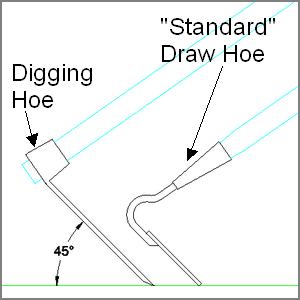
Why is the most commonly available garden hoe also the worst one to use?
Here is my educated opinion, from being in the garden tool business for 11 years... The reason is that many decades ago, digging hoes became hard to get, and some tool company beefed up a standard draw hoe in a poor attempt to create a replacement for digging hoes. Look at the drawing, see how the geometry matches?

It does not work for two reasons:
One, the hoe head does not have enough weight to allow it to chop through hard ground. The weight ratio for a digging hoe head is 1/2 pound per inch. This means that a 4" wide blade needs to weigh 2 pounds, and a 6" wide head needs to weigh 3 pounds. Standard draw hoes heads are much lighter than this, so they just bounce off of hard soil.
Two, the head-to-handle connection is not strong enough. A real digging hoe has a beefy connection that is designed to withstand the chopping forces. But a draw hoes has a light cone connection, so an hour or two of chopping with it usually results in the head breaking off the handle.
So is there any hope for this sub-group of draw hoes?
YES - if the neck is light enough, check out our
INSTRUCTIONS
for how to properly adjust the blade.
BUT -if the neck is too thick to adjust, they are still good for things like pulling loose soil into hills or ridges,
spreading gravel, and mixing concrete.
● American Standard
● Draw Hoe
● Paddle Hoe
● Pattern Hoe
● Gooseneck Hoe

American Standard
Typical big-box model

Draw Hoe
Neck too thick to bend
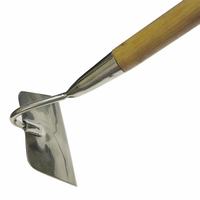
Better design!
Angle easy to adjust
Light Draw Hoes:
These are much better that the standard models, even though they are called “light”. The reason is that it is much easier to adjust the angle, because the necks tend to be lighter and longer. Once these are properly adjusted, they quickly and easily scrape through the top layer of soil to tumble, slice, or uproot the weeds. They are not made for hacking, which could bend the necks.
● Swan Neck Hoe
● Floral Hoe
● Onion Hoe
● Trapezoid Hoe
● Half Moon Hoe
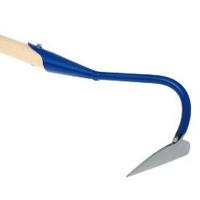
Swan Neck Hoe
Long neck easy to adjust
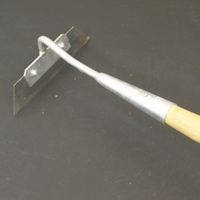
Trapezoid Hoe
Replaceable blade
Heavy-duty Draw Hoes:
These are the oldest and strongest models. Their blade angle is not meant to be adjustable. So it is important they be designed properly, and have a long handle to give you options of where to hold it to create the proper angle.
These are strong enough to hack through big weeds and grass clumps, but also sharp enough to scrape through the soil to slice and uproot small weeds. When designed properly, they are very fast aggressive weeders. But they are too big for fine weeding up close to crops, so best used for for paths, rows, and open spaces.
● Grape Hoe
● Scovil Hoe
● Eye Hoe
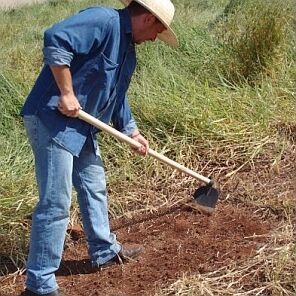
Eye Hoe in use
Pointed & Plow style Draw Hoes
This bunch is together because the blades are long and pointed, and they are drawn through the soil in longer strokes. Some can be used for weeding in tight spaces, but the more common uses are to create long straight furrows for seeding, or to loosen and till the soil by plowing it.
● Warren Hoe
● Pointed Hoe
● Korean Ho-Mi
● Plow Hoe
● EZ Digger

Pointed Hoe
Miscellaneous Draw Hoes:
This is the last of the odd-and-end draw hoes, before we move on to the reciprocating hoes.
Tined Hoes: These have either a single or multiple tines, and are pulled through the soil to loosen and till it. They are good for opening up crusted soil. The single-tine models can be used for weeding in tight spaces between crop plants.
Circle Hoe: I have never used one, though they have some good reviews. Not sure how adjustable that blade angle is, your experience will probably be very dependent on your height and your soil situation.
● Cultivator Hoe
● Cobra Hoe
● Circle Hoe
Group #3: Reciprocating Hoes
Action = Back and forth scrubbing motion
Purpose = Weeding in medium or soft soil
This group is the only ones with moving parts. The narrow blade has a pivot that lets it easily skim across the top of the soil on the forward stroke, then scrape and churn through the soil at a shallow angle (20 degrees) as you pull the hoe backward. The shallow angle will cut smaller weeds and uproot the rest.
Heavily built versions can used pretty aggressively for preparing soil or weeding between the rows. While lighter models are used close to crop plants to weed the uppermost layer of soil without damaging your crop's roots.
Most hoes in this category of hoe do not have an adjustable handle angle. So for those, a proper starting design and a long handle are critical. Try before you buy. But there is one, called the Switchblade Hoe, that does have a fully adjustable handle and interchangeable heads.
Names of Reciprocating Hoes:
● Oscillating Hoe
● Action Hoe
● Hula Hoe
● Stirrup Hoe

Stirrup Hoe
*with adjustable handle

Make sure it moves!
This one might not...
Group #4: Flat Hoes
Action = Push and pull
Purpose = Weeding in loose or soft soil
I called these "flat" because the blades lay parallel to the soil surface. They are moved back and forth just under the soil surface to cut or uproot small weeds. They are not meant for hard or baked soil, though you could loosen such soil first with a Tined Draw Hoe and then use a flat hoe to finish it up.
These come in almost every geometric shape. The edges are either sharp or saw-toothed. Beware of claims of "Self-Sharpening" - rubbing a tool around in the dirt never sharpens it.
The blade must lay flat on the ground while holding the handle in a comfortable position. So it is important to pick one that has an adjustable neck. Click here to read: Can I adjust a garden hoe to match my height?
Here's the usual ones...
● Push Hoe
● Speed Hoe
● Heart Hoe
● Diamond Hoe
● Scuffle Hoe
...and the unusual.
● Winged Weeder
● Push-n-Pull
● Hooke and Crooke
● Swoe Hoe

Winged Weeder
Beware of the Dutch Hoe! There are some out there that are ONLY meant for pushing. I do not know why you would give up half the capability of the tool by not also designing them for a pulling action, but here they are. And there are some out there that do not have adjustable blades. But there are also some excellent ones, which we have shown below.

Bad design:
Not adjustable, no sharp rear edge.

Better design:
Adjustable, but no sharp rear edge.
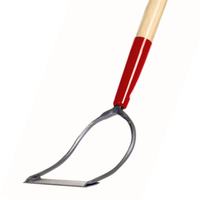
Thin blade?
May be better than wide blade.

Aggressive!
For the big tough weeds.
Group #5: Sweeping Hoes
Action = Shallow sweeping and slicing action
Purpose = Weeding in loose or soft soil
This group is the most modern, and their invention is usually credited to Eliot Coleman from the 1980's, but some of the versions were developed by other people in other countries.
They are used with the handle held fairly upright, with your thumbs pointing upwards and the blade (or the wire) near your feet. The blade is swept back and forth in short strokes to cut or uproot small weeds. Looking straight down at the blade allows more accuracy when working close to your crops.
Sweeping hoes & Detail weeders...
● Collinear Hoe
● Upright Hoe
● Coleman Hoe
● Swage Hoe
● Loop Hoe
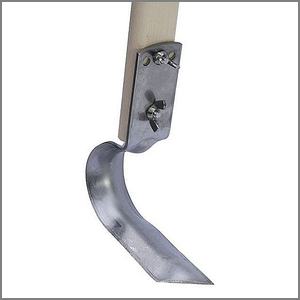
Swage Hoe
Wire Weeders are different! These special non-cutting wire hoes can be used in unique ways. They pull out small weeds - roots and all - with minimal soil disturbance.
And they are safe to use with drip tape and other irrigation tubing.
Since they are only used in loose soil, they can use a lighter head-to-handle connection. The pictures show some unique methods for connecting the wire loops to the handle. The Neversink model uses the same hex shank quick-change socket used by many screw guns. While the Switchblade model uses a pair of pins and clips to attach a variety of widths of wire loops.

Wire Weeder
Sweep or pull along.

Quick change:
using hex shank bits.

Wire Hoe
with multiple heads

Uproots tiny weeds by just pulling them out, by dragging just below the surface.
Which type of hoe should I buy?
As I'm sure you figured out from reading this far, the answer is either "It depends" or "A couple different ones".
A garden hoe is NOT a Swiss Army Knife. There is not one that will do it all.
So list out what sort of garden chores you need to do, such as:
- break sod to make a growing space
- till and loosen hard soil
- remove large established weeds
- kill medium weeds in tight spaces
- maintenance weed often with minimal effort
Then pick through your tool shed, or do some online shipping (many of these tools are not found in regular stores), and find the best one for each task you need to do. Remember to look for long handles on all types, and for adjustable heads on the draw and flat hoes.
Don't be surprised if you end with a half-dozen hoes! That is pretty typical for gardeners who like to work smart, not hard.
ARTICLES ABOUT GARDEN HOES AND WEEDING

Staff Author: Greg Baka is the founder of EasyDigging.com
He is also an experienced gardener and home remodeling DIY'er. He has tackled everything from underground drainage to metal roofing, and all things in between. Using his engineering degree, he designed a variety of construction and excavating equipment.
Check out our Gardening and Digging Tools!
EasyDigging.com sells a variety of heavy-duty tools for gardening, landscaping, construction, and small-scale agriculture.
Just click one of the product types in the green menu above...▲
Check out our Gardening and Digging Tools!
EasyDigging.com sells a variety of heavy-duty tools for gardening, landscaping, construction, and small-scale agriculture.
Just click HERE to shoot back up to the top of the page, then open the "Product Menu" in the big green bar.








